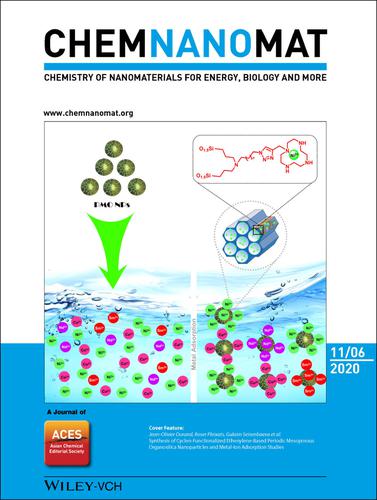当前位置:
X-MOL 学术
›
ChemNanoMat
›
论文详情
Our official English website, www.x-mol.net, welcomes your
feedback! (Note: you will need to create a separate account there.)
Cover Feature: Synthesis of Cyclen‐Functionalized Ethenylene‐Based Periodic Mesoporous Organosilica Nanoparticles and Metal‐Ion Adsorption Studies (ChemNanoMat 11/2020)
ChemNanoMat ( IF 2.6 ) Pub Date : 2020-10-15 , DOI: 10.1002/cnma.202000490 Hao Li 1, 2 , Ani Vardanyan 3 , Clarence Charnay 2 , Laurence Raehm 2 , Gulaim A. Seisenbaeva 3 , Roser Pleixats 1 , Jean‐Olivier Durand 2
ChemNanoMat ( IF 2.6 ) Pub Date : 2020-10-15 , DOI: 10.1002/cnma.202000490 Hao Li 1, 2 , Ani Vardanyan 3 , Clarence Charnay 2 , Laurence Raehm 2 , Gulaim A. Seisenbaeva 3 , Roser Pleixats 1 , Jean‐Olivier Durand 2
Affiliation

|
Why would heavy metal ever go away? Cyclen‐functionalized ethenylene‐based periodic mesoporous organosilica nanoparticles were prepared for heavy metal removal from model solutions. The kinetics and isotherms of adsorption of nickel and cobalt were determined, and these nanomaterials showed high uptake of metals (up to 3.9 mmol g−1). They demonstrated pronounced selectivity in the separation of rare earth elements (e.g., neodymium and samarium) from late transition metals, e.g. Ni(II) and Co(II), by adsorption and even more so by controlled desorption. More information can be found in the Full Paper by Jean‐Olivier Durand, Roser Pleixats, Gulaim Seisenbaeva et al.

中文翻译:

封面功能:循环功能化的基于乙烯的周期性介孔有机硅纳米粒子的合成和金属离子吸附研究(ChemNanoMat 11/2020)
为什么重金属会消失?为从模型溶液中去除重金属,准备了具有Cyclen功能的基于乙炔的周期性介孔有机二氧化硅纳米粒子。测定了镍和钴的吸附动力学和等温线,这些纳米材料显示出高的金属吸收率(高达3.9 mmol g -1)。他们证明了通过吸附,尤其是通过受控脱附,从后期过渡金属(例如Ni(II)和Co(II))中分离稀土元素(例如钕和sa)具有显着的选择性。更多信息可以在Jean-Olivier Durand,Roser Pleixats,Gulaim Seisenbaeva等人的论文全文中找到。

更新日期:2020-11-06

中文翻译:

封面功能:循环功能化的基于乙烯的周期性介孔有机硅纳米粒子的合成和金属离子吸附研究(ChemNanoMat 11/2020)
为什么重金属会消失?为从模型溶液中去除重金属,准备了具有Cyclen功能的基于乙炔的周期性介孔有机二氧化硅纳米粒子。测定了镍和钴的吸附动力学和等温线,这些纳米材料显示出高的金属吸收率(高达3.9 mmol g -1)。他们证明了通过吸附,尤其是通过受控脱附,从后期过渡金属(例如Ni(II)和Co(II))中分离稀土元素(例如钕和sa)具有显着的选择性。更多信息可以在Jean-Olivier Durand,Roser Pleixats,Gulaim Seisenbaeva等人的论文全文中找到。












































 京公网安备 11010802027423号
京公网安备 11010802027423号